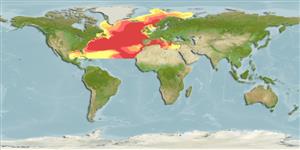Preferred temperature (Ref.
123201): 2.7 - 14.2, mean 8.6 °C (based on 494 cells).
Phylogenetic diversity index (Ref.
82804): PD
50 = 0.6250 [Uniqueness, from 0.5 = low to 2.0 = high].
Bayesian length-weight: a=0.00501 (0.00283 - 0.00889), b=3.16 (3.00 - 3.32), in cm total length, based on LWR estimates for this species & (Sub)family-body (Ref.
93245).
Niveau trophique (Ref.
69278): 3.3 ±0.38 se; based on food items.
Generation time: 0.8 ( na - na) years. Estimated as median ln(3)/K based on 2
growth studies.
Résilience (Ref.
120179): Milieu, temps minimum de doublement de population : 1,4 à 4,4 années (tmax=2; Fec=2,134; K=1.3-3.65;).
Fishing Vulnerability (Ref.
59153): Low vulnerability (10 of 100).
Nutrients (Ref.
124155): Calcium = 198 [55, 540] mg/100g; Iron = 0.649 [0.223, 2.202] mg/100g; Protein = 17.3 [15.2, 19.2] %; Omega3 = 0.641 [0.226, 1.734] g/100g; Selenium = 20.9 [6.3, 75.0] μg/100g; VitaminA = 55.6 [6.1, 502.7] μg/100g; Zinc = 1.23 [0.59, 2.66] mg/100g (wet weight);
